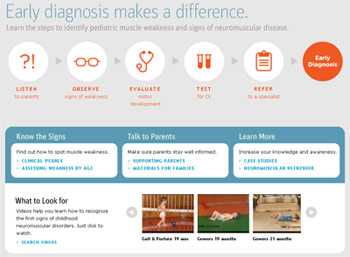Diagnostic Tools
Early Identification
CDC supports early identification and evaluation of motor delays. Early screening and identification can reduce the “diagnostic odyssey” that families of children with motor delays may face as they spend years visiting different doctors and undergoing many tests to reach a correct diagnosis. Early screening can identify children more likely to have motor delays, and enable a quicker referral to a specialist for diagnosis.
Early identification can lead to faster access to beneficial early intervention programs or special education resources. Early intervention services are designed for children under three years old and include services like therapy to help the child talk, walk, and interact with others. Special education instruction can help children with a disability who are more than three years old with a range of educational and developmental assistance. These might include learning to read, write, or remember new information, or therapy for trouble with behavior or emotions.
An AAP clinical report, funded by CDC in 2013, emphasized the importance of “pursuing diagnostic tests while concurrently referring patients to early intervention programs.” A diagnostic test determines whether a person has or does not have a specific disease. The clinical report includes an algorithm, or step-by-step solution, for screening and then testing children with high or low muscle tone (stiff muscles or muscles that are weak). The algorithm also lists “red flags” for prompt referral to a specialist. Muscular dystrophy and cerebral palsy are two motor-related disorders that may be identified using this clinical report.
Pediatricians need to regularly screen, identify and evaluate babies and young children for delays in motor development, according to recommendations in a new clinical report funded by the Centers for Disease Control and Prevention (CDC). Motor development is how a child’s brain and muscles become able to move parts of the body like arms, fingers, legs, and head, and to work together so the child can get around (such as in walking, running, and climbing).
Published by the American Academy of Pediatrics (AAP) in June of 2013, the clinical report “Motor Delays: Early Identification and Evaluation” encourages early screening and identification by pediatricians. Recent AAP guidelines have focused on language and social development. This report recognizes the importance of motor development.
Delays in motor development can include:
- sitting
- standing
- walking
- running
- going up stairs
Web-based Tools for Parents
In 2016, the second phase of this collaboration with AAP involved the development of a new web-based tool, called Physical Developmental Delays: What to look for. This tool is designed to reduce the time to finding a diagnosis and getting children with delays in their physical development into services.
Learn more about the new tool >>
What You Can Do
- Parents: You know your child best. Talk to your child’s health care professional if you have concerns about the way your child plays, learns, speaks, moves or behaves at home, in school, or with friends.
- Health care professionals: Early diagnosis and appropriate treatment based on updated guidelines is very important.
- Teachers/school administrators: Early identification is important, so that children can get the help they need. Work with families and health care professionals if you have concerns about a child in your school.
Web-based Tool for Healthcare Professionals
CDC research has indicated that individuals affected by the most severe form of muscular dystrophy—Duchenne muscular dystrophy—experience a significant delay in receiving an accurate diagnosis. Most of them are not diagnosed until 5 years of age. Despite improvements in diagnostic testing, this figure has not changed in 20 years1. Delays in diagnosis may mean a delay in accessing care, and may have practical implications for the family.
CDC has funded development of the only early diagnosis tool designed specifically for identifying muscle weakness among children. The agency’s muscular dystrophy program collaborates with partners to create tools to help to improve the lives of people with muscular dystrophy. To this end, CDC has funded Parent Project Muscular Dystrophy to establish the National Task Force for the Early Identification of Neuromuscular Disorders. The result of the task force’s work is www.childmuscleweakness.org, a Web-based tool to help primary care clinicians, therapists, and other specialists in the early diagnosis of child muscle weakness. This tool is designed to decrease the time between initial signs and first diagnosis, and improve early intervention and access to care.
The core content of this Web tool has been endorsed by the American Academy of Pediatrics. The site features a video library of clips showing specific neuromuscular features.
Read the Medscape Expert Commentary about this diagnostic tool for healthcare professionals.
Links to other websites
Bright Futures Program (American Academy of Pediatrics)
Center for Parent Information and Resources
References
- Centers for Disease Control and Prevention (CDC). Prevalence of Duchenne/Becker muscular dystrophy among males aged 5-24 years – four states, 2007. MMWR Morb Mortal Wkly Rep. 2009 Oct 16;58(40):1119-22
- Page last reviewed: January 13, 2017
- Page last updated: January 30, 2017
- Content source:



 ShareCompartir
ShareCompartir
